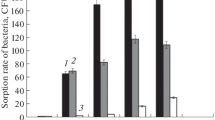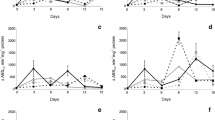Abstract
A simple model system was designed to detect positive effects ofAzospirillum on the root growth of cereals. Cultures ofA. brasilense Sp7 andA. lipoferum Sp59 did not excrete gibberellins and cytokinins in the logarithmic and in the early stationary growth phase. Indoleacetic acid (IAA) was formed, however, only in the stationary phase of the cultures. The addition of D,L-tryptophan to the medium enhanced the formation of IAA. A further, still unidentified substance was produced byAzospirillum under denitrifying conditions in the logarithmic growth phase. The substance was almost twice as active as IAA in increasing the wet weight of wheat root segments. It is suggested that this unidentified substance is the major stimulus affecting the growth of cereals.
Similar content being viewed by others
References
Biddington NL and Thomas TH 1973 A modifiedAmaranthus betacyanin bioassay for the rapid determination of cytokinins in plant extracts. Planta (Berl.) 111, 183–186.
Blakely LM, Blakely RM and Galloway CM 1986 Effects of dimethyl sulfoxide and pH on indoleacetic acid induced lateral root formation in the radish seedling root. Plant Physiol. 80, 790–791.
Bothe H, Klein B, Stephan MP and Döbereiner J 1981 Transformations of inorganic nitrogen byAzospirillum spp. Arch. Microbiol. 130, 96–100.
Danneberg G, Zimmer W and Bothe H 1985 Some physiological and biochemical properties of denitrification byAzospirillum brasilense.In Azospirillum III, Genetics, Physiology, Ecology, Ed. W Klingmüller. pp 127–138, Springer, Berlin, Heidelberg.
Döbereiner J 1983a Dinitrogen fixation in the rhizosphere and phyllosphere association.In Inorganic Plant Nutrition. A.Läuchli and RL Bieleski (eds.). Encycl. Plant Physiol., New Series, Vol. 15A, pp 33–35. Springer, Berlin, Heidelberg, New York.
Döbereiner J 1983b Ten years ofAzospirillum.In Azospirillum II. Genetics, Physiology, Ecology. Ed. W. Klingmüller pp. 9–23. Birkhäuser, Basel, Boston, Stuttgart.
Elmerich C 1984 Molecular biology and ecology of diazotrophs associated with non-leguminous plants. Bio/Technology 2, 967–978.
Frankland B and Warening PF 1960 Effect of gibberellic acid on hypocotyl growth of lettuce seedlings. Nature (London) 185,225–226.
Hartmann A, Singh M and Klingmüller W 1983 Isolation and characterization ofAzospirillum mutants excreting high amounts of indoleacetic acid. Can. J. Microbiol. 29, 916–923.
Jones RL and Varner JE 1967 The bioassay of gibberellins. Planta (Berl.) 72, 155–161.
Kapulnik Y, Okon Y and Henis Y 1985 Changes in root morphology of wheat caused byAzospirillum inoculation. Can. J. Microbiol. 31, 881–887.
Kleeberger A, Castorf H and Klingmüller W 1983 The rhizosphere microflora of wheat and barley with special reference to Gram negative bacteria. Arch. Microbiol. 136, 306–311.
Libbert E 1957 Die Regulation des Wurzelwachstums durch synthetische und endogene Inhibitoren. Planta (Berl.) 5, 25–40.
Lindberg T and Granhall U 1984 Isolation and characterization of dinitrogen fixing bacteria from the rhizosphere of temperate cereals and forage grasses. Appl. Environ. Microbiol. 48, 683–689.
Nelson LM and Knowles R 1978 Effect of oxygen and nitrate on nitrogen fixation and denitrification byAzospirillum brasilense grown in continuous culture. Can. J. Microbiol. 24, 1395–1403.
Neuer G, Kronenberg A and Bothe H 1985 Denitrification and nitrogen fixation byAzospirillum III. Properties of a wheatAzospirillum association. Arch. Microbiol. 141, 364–370.
Okon Y 1985Azospirillum as a potential inoculant for agriculture. Trends Biotechnol. 3, 223–228.
Reynders L and Vlassak K 1979 Conversion of tryptophan to indoleacetic acid byAzospirillum sp. Soil Biol. Biochem. 11, 547–548.
Thomas-Bauzon D, Weinhard P, Villecourt P and Balandreau J 1982 The spermosphere model: Its use in growing, counting and isolating N2-fixing bacteria from the rhizosphere of rice. Can. J. Microbiol. 28, 922–928.
Tien TM, Gaskin MH and Hubbell DH 1979 Plant growth substances produced byAzospirillum brasilense and their effect on the growth of pearl millet (Pennisetum americanum L.). Appl. Environ. Microbiol. 37, 219–226.
Weiler EW 1984 Immuno assay of plant growth regulators. Annu. Rev. Plant Physiol. 35, 85–95.
Whallon JH, Acker G and El-Khawas H 1985 Electron microscopy of young wheat roots inoculated withAzospirillum.In Azospirillum III. Genetics, Physiology, Ecology. Ed. W Klingmüller. pp 222–229, Springer, Berlin, Heidelberg.
Zimmer W, Roeben K, Danneberg G and Bothe H 1987 The bacterial genusAzospirillum and its potential applications.In Inorganic Nitrogen Metabolism. Ed. W Ullrich. pp 177–182. Springer, Berlin, Heidelberg.
Author information
Authors and Affiliations
Additional information
Dedicated to Professor E.-G. Niemann, Hannover, on the occasion of his 60th birthday.
Rights and permissions
About this article
Cite this article
Zimmer, W., Bothe, H. The phytohormonal interactions betweenAzospirillum and wheat. Plant Soil 110, 239–247 (1988). https://doi.org/10.1007/BF02226804
Issue Date:
DOI: https://doi.org/10.1007/BF02226804




